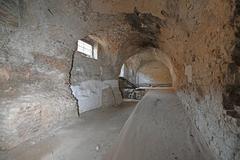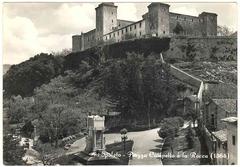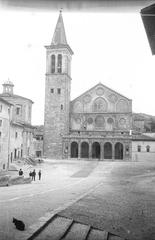Castello di Morgnano: Visiting Hours, Tickets, and Complete Guide to Spoleto Historical Sites
Date: 14/06/2025
Introduction
Perched on the undulating hills north of Spoleto, Umbria, Castello di Morgnano stands as a testament to the region’s layered history—seamlessly blending medieval fortifications with a rich industrial and mining legacy. Offering breathtaking panoramic views over the Valle Umbra and beyond, this historic site invites visitors to immerse themselves in centuries of local resilience, architectural evolution, and community spirit. Whether you are passionate about medieval castles, interested in industrial heritage, or simply planning a scenic day trip from Spoleto, Castello di Morgnano delivers an enriching and memorable experience (Umbria Tourism; Castelliere Blog).
Established in the 12th–13th centuries as a fortified village, the castle played a strategic defensive role along the Via Flaminia, safeguarding local communities and trade. In the 19th and 20th centuries, the area became synonymous with mining, particularly via the Pozzo Orlando shaft, shaping the social and economic fabric of Morgnano until the mines’ closure in 1961 (Museo delle Miniere di Morgnano).
This guide presents all the practical information you need: visiting hours, tickets, accessibility, historical context, cultural events, travel tips, and nearby attractions—ensuring a well-planned visit to one of Umbria’s most fascinating historical sites.
Table of Contents
- Introduction
- Getting to Castello di Morgnano
- Visiting Hours and Tickets
- Accessibility and Visitor Tips
- Historical Overview
- Cultural Highlights and Local Legends
- Guided Tours and Special Events
- Practical Visitor Information
- FAQ
- Visuals and Media
- Conclusion
- Plan Your Visit
Getting to Castello di Morgnano
Location: Morgnano-Santa Croce, approx. 8 km northeast of Spoleto’s historic center, Umbria, Italy (Castello di Morgnano)
By Car
From Spoleto, follow the SP457 or local roads to Morgnano-Santa Croce. The drive takes 15–20 minutes. Parking is available in Morgnano village or at the base of the hill. The last stretch features narrow rural roads; drive carefully, especially in inclement weather.
By Public Transport
Public transport is limited; some regional buses from Spoleto may stop near Morgnano. Always consult the latest schedules via Umbria Mobilità or the Spoleto Tourist Information Office before departing.
On Foot or By Bike
Active visitors can enjoy hiking or cycling from Spoleto. The 8 km trek takes about 1.5–2 hours each way, winding through olive groves and gentle hills—ideal in spring or autumn (Strictly Italy).
Visiting Hours and Tickets
As of June 2025, Castello di Morgnano is undergoing restoration and is not regularly open. Access is limited to scheduled guided tours and cultural events (Castello di Morgnano).
- Visiting Hours: Check the official website for up-to-date schedules of special events and tours.
- Tickets: Advance booking is required for tours/events. Ticket prices vary; some events are free or donation-based. Always confirm in advance.
Note: For the Museo delle Miniere di Morgnano, admission is free and opening hours may expand during festivals. Consult the museum’s website for current information.
Accessibility and Visitor Tips
- Terrain: Reaching the castle involves a moderate uphill walk over gravel and steps. The site is not wheelchair accessible at present.
- Best Time to Visit: Spring and autumn offer mild weather and vibrant landscapes. Summer is quieter but warmer; bring sun protection.
- What to Bring: Comfortable shoes, water, snacks, layered clothing, and a camera for panoramic shots.
- Facilities: There are no on-site restrooms, food vendors, or shops. Nearest amenities are in Morgnano village or Spoleto.
- Safety: Stay on marked paths. Respect restoration zones and all posted instructions.
Historical Overview
Medieval Origins and Strategic Importance
Dating back to the 12th and 13th centuries, Castello di Morgnano was integral to the Duchy of Spoleto’s defense, protecting vital routes like the Via Flaminia. Its robust walls and towers exemplify medieval military architecture (Umbria Tourism).
Feudal Control and Community Life
The castle housed villagers, soldiers, and clergy, featuring a keep, chapel, and communal spaces. This self-sufficient community managed agriculture, justice, and local administration (Castelliere Blog).
Renaissance Decline and Transformation
From the 15th century, the rise of artillery reduced the castle’s military value. It became a rural estate, with many structures repurposed for agriculture (Comune di Spoleto).
Modern Rediscovery and Preservation
Interest in Umbria’s castles revived in the 19th–20th centuries. Today, visitors find restored masonry, interpretive panels, and marked paths (Visit Umbria).
Industrial and Mining Heritage
In the late 19th century, Morgnano’s role shifted from defense to industry. The Pozzo Orlando shaft became the region’s mining hub, extracting lignite and employing generations of locals until 1961 (Museo delle Miniere di Morgnano). The mining disaster of 1955, which claimed 23 lives, is memorialized at the village entrance.
Cultural Highlights and Local Legends
- Secret Tunnel Legend: Local folklore tells of a hidden passage connecting the castle to the Abbey of San Ponziano, reflecting the entwined histories of religious and military institutions.
- Mining Heritage: The Museo delle Miniere di Morgnano preserves the memory of the miners, with tours led by former workers offering personal insights into local life and labor (Museo delle Miniere di Morgnano).
Guided Tours and Special Events
- Guided Tours: Offered during special events and by arrangement, often led by local historians or former miners. These tours provide rich historical context and personal stories.
- Annual Events: Summer brings festivals like “Miniera d’agosto,” National Mining Day, and “Brindando sotto le stelle,” combining history with community celebrations, music, and food.
Practical Visitor Information
Facilities
- Restrooms: Available at the mining museum.
- Refreshments: Limited; nearby Morgnano or Spoleto offers more choices.
- Souvenirs: Occasional books and mementos at the museum.
Nearby Attractions and Activities
- Museo delle Miniere di Morgnano: Immersive mining museum experience (WhichMuseum).
- Spoleto Historic Center: Explore the Roman Theater, Rocca Albornoziana, and Duomo (Strictly Italy).
- Hiking/Cycling: Trails connect Morgnano with Spoleto and countryside.
Local Dining and Accommodation
- In Spoleto:
- Ristorante Apollinare: Seasonal Umbrian cuisine.
- Il Tempio del Gusto: Local ingredients, creative menu.
- Stay:
- Domus Fontis Pescaia: Guesthouse in the historic center.
- Palazzo Leti: Luxury 17th-century palace hotel.
Language and Customs
Italian is widely spoken; English is less common in rural areas. Learn basic Italian greetings. Dress modestly for churches and greet locals with “Buongiorno.”
Health and Safety
- The area is safe for tourists (Champion Traveler).
- Closest hospital and pharmacies are in Spoleto.
- Emergency number: 112.
Frequently Asked Questions (FAQ)
Q: What are the current visiting hours?
A: Regular hours are unavailable during restoration. Access is limited to special tours/events—always check the official website.
Q: Are tickets required?
A: Yes, for special events/tours. Some are free or donation-based.
Q: Is the castle accessible for wheelchairs?
A: No; uneven terrain and restoration limit accessibility.
Q: How do I get there from Spoleto?
A: By car (15–20 minutes), limited public transport, or on foot/bike via scenic trails.
Q: When is the best time to visit?
A: Spring and autumn for pleasant weather and landscapes.
Visuals and Media
- Photo galleries: Available on the official websites, featuring panoramic views, restored masonry, and historic mining structures.
- Maps: Interactive maps show the castle’s position relative to Spoleto and attractions.
- Alt tags: Use descriptive alt text for web accessibility—e.g., “View of Castello di Morgnano walls,” “Panoramic Umbrian countryside from Morgnano.”
Conclusion
Castello di Morgnano is more than a medieval fortress—it’s a living symbol of resilience, continuity, and the rich interplay between history and community. Though currently under restoration, scheduled guided tours and cultural events allow visitors to experience its layered past first-hand. The combination of medieval architecture, industrial mining heritage, sweeping vistas, and vibrant local traditions makes it a must-see for anyone exploring Umbria.
To maximize your experience, plan ahead: verify visiting hours, book tours in advance, and consider aligning your visit with local festivals or events. Combine your trip with nearby Spoleto attractions and immerse yourself in the unique spirit of Morgnano’s community.
For ongoing updates, ticket bookings, and personalized travel assistance, consult the official sites and consider the Audiala app for offline maps, insider tips, and exclusive content.
Sources and Official Links
- Umbria Tourism - Castello di Morgnano
- Castello di Morgnano Official
- Museo delle Miniere di Morgnano
- Castello di Morgnano Main Site


